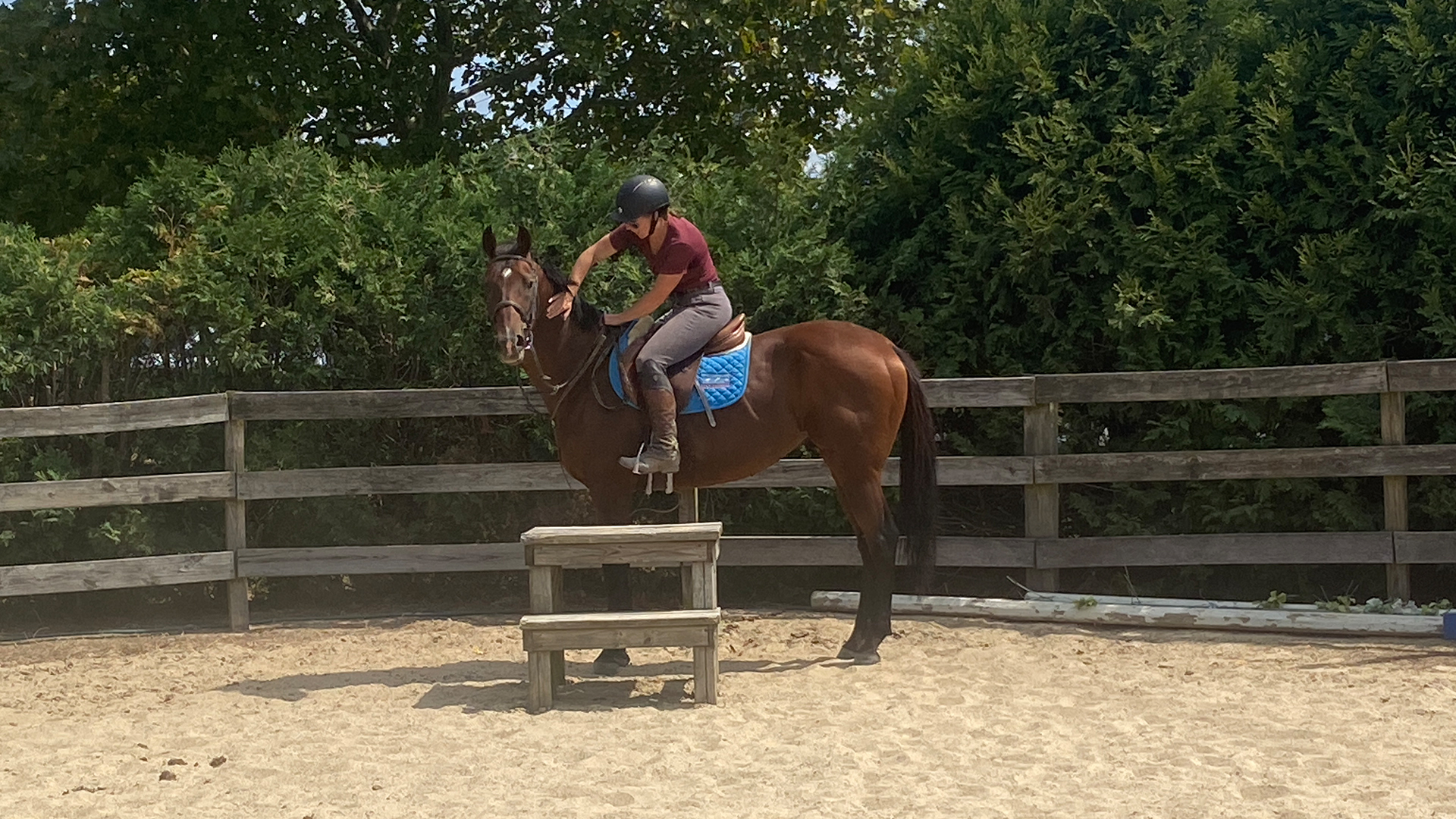Mounting Block
All Posts & News Press Releases Success Stories Aftercare Editorials Retraining Tips Supporter Features Inspector Spotlights Hamburger Toggle Menu Previous Post The First Ride The First Ride By: Alexis Arbaugh April 3, 2025 Retraining Tags:MidAtlantic Horse Rescue, Mounting, Mounting Block, Retraining, Retraining Tip, Thoroughbred Aftercare, Thoroughbred Aftercare Alliance Aint Wasting Time’ first ride The first ride on a recently retired Thoroughbred racehorse can be quite daunting, especially for those new to it. Even experienced riders might find it intimidating. These horses are fresh off the racetrack, often highly muscled, fit, and powerful—qualities that make them incredibly fast and strong but also a bit overwhelming for immediate riding. Most owners give their retired racehorses a break before starting any retraining. This downtime allows the horse to relax, adjust to its new environment, and lose some of that racetrack muscle. It is crucial for starting the retraining process with a clean slate. Thoroughbred Aftercare Alliance had the pleasure of speaking with Beverly Strauss, one of the co-founders of MidAtlantic Horse Rescue in Chesapeake City, Maryland, about the first ride off the racetrack. MidAtlantic, a Thoroughbred Aftercare Alliance-accredited organization, cares for more than 45 horses across their main facility and satellite farms. They work closely with racetracks to take horses directly off the track and rescue them from auctions and feed lots. Once the horses arrive, they are carefully evaluated for rideability, trained, and placed into adoptive homes. In addition to her aftercare work, Bev and her husband run a small Thoroughbred racing business at Delaware Park. With her extensive knowledge both on and off the racetrack, Bev is a highly skilled horsewoman who ensures the best outcomes for all her horses. “One of the great things about OTTBs is the solid foundation that most of them have,” Bev wrote. Many are already well-versed in walking, jogging, cantering, galloping, and automatically changing leads, both independently and in groups. These young Thoroughbreds are exposed to a lot of commotion during early morning workouts and race days, learning to stay relaxed even in busy environments. Whether they race for ten years or not at all, they come away highly desensitized. There are a few key similarities between racehorse riding and sport horse riding. In both disciplines, riders must have excellent balance, whether perched atop the horse or with their legs securely wrapped around its barrel, and maintain a quiet, steady hand. Bev points out that the mindset is also often the same—if a horse gets “spicy,” the rider laughs it off and pushes the horse forward, making sure not to let the horse get away with anything. Just like training racehorses, there are various approaches to retraining them. Some trainers prefer groundwork, while others, like Bev and her team at MidAtlantic, prefer to hop right on without any groundwork. However, before riding, they ensure the horse is sound, eats well, and is maintaining a healthy weight—key factors that indicate the horse is ready to start work. Much of the tack used on the racetrack is similar to what you’ll use when retraining. Since this will be a new experience for the horse, keeping familiar elements can help them feel more at ease. At MidAtlantic, they prefer to start all their horses in a D snaffle with a lozenge in the middle. The D snaffle is the same as on the track. On the track, D snaffles typically have one joint, while off the track, they often have two joints. Both bits are gentle, but double-jointed snaffles are the softest, making them ideal for horses starting a new career. At MidAtlantic, they also use a very loose running martingale on all their horses, as it’s similar to a yoke and rings. A running martingale provides more control by applying pressure and preventing the horse from raising its head too high. While a yoke with rings is typically made of nylon rather than leather, it serves the same purpose. Although English and jockey saddles differ in size, they generally sit in the same spot on the horse’s back, so there is little difference in how it makes the horse feel. Aint Wasting Time’s first ride Some trainers prefer the intimacy of working in a round pen, but Bev has a different approach. “I personally don’t like riding in a round pen because there isn’t much room, and it’s hard for the horse to balance, always being on a turn,” she explains. She also points out the limited space to regain control if the horse becomes unruly. Instead, Bev starts all their horses in an arena, which offers more space for free movement and helps the horse feel less confined. Bev also rarely lunges a horse before the first ride, only “if the horse acts girthy or uncomfortable, but only maybe one or two times out of over 100 first rides.” MidAtlantic places a strong emphasis on using voice cues during the first few rides. Depending on how much and what kind of training the horse had previously, their understanding of leg pressure will vary. For instance, a horse that was hacked as a youngster might already have an idea of what leg pressure means. “Smooching or clucking helps while they learn what the leg means,” Bev writes. Another common issue is the horse’s ability to steer, which also depends on their prior training. For example, a horse that was long-lined will typically have better steering skills. The mounting block is often a foreign object to a racehorse, and it can take time for the horse to get used to it. At MidAtlantic, they use a large, three-step wooden block positioned on a curve, away from the wall. This setup allows the horse to be placed between the block and the fence, creating a barrier to keep the horse still. Some horses are unfazed by the block, while others might be wary and avoid it. “In those cases, we’ll sit on the block and chat until the horse relaxes and approaches it,” Bev says. Ain Wasting Time’s
Read More >













